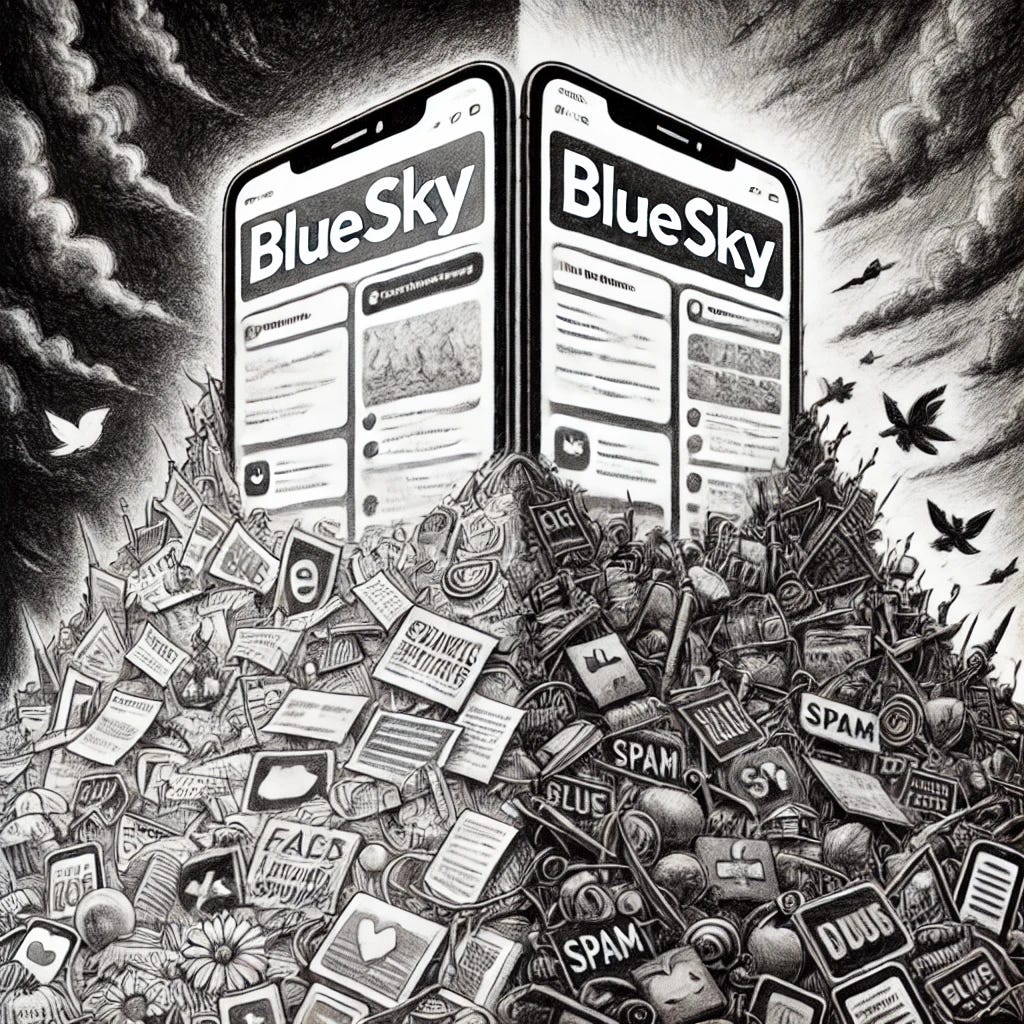Bluesky: Will or won’t they enshit?
For now, Bluesky is a freer, less profit-driven internet — but can it last?
Social networks traffic in desire.
Today’s Bluesky, a social app developed by former Twitter employees, is most obviously a foil to other text-based networks like Threads and X. And yet, it describes itself as “social media as it should be.” Unlike the other platforms, there aren’t any ads. Users own their own data. Privacy controls are nuanced and core to the experience. The company doesn’t have any major revenue streams at present.
On most platforms, algorithms sniff out your desires — tracking all those clicks like blood in the water — and reflect them back to you. Whether explicit or latent, your desires are catalogued and used to ensnare your attention. On Bluesky, your desires are not weaponized. It’s a platform that’s predicated upon user choice, not corporate profits. At least for now.
I find Bluesky’s approach to be quietly revolutionary, a calm in the storm. On X, you might have to read the world’s richest man’s gripes at the top of your feed every day. On TikTok, you might have to navigate a creator’s monologue on load. On Bluesky, you curate the content, the volume, and the timbre of your experience.
Bluesky is built on the AT Protocol, making it interoperable with other tools and ecosystems. Users can move freely between different servers (i.e. where your data is hosted) and clients (i.e. where you have the experience). For example, you can host your own Bluesky server, with your own moderation rules, but access Bluesky content through a third-party app like Graysky. This is what Bluesky CEO Jen Graber means when she says “protocols over platforms.”
Onboarding. Bluesky centers your desires from the very beginning. When I first join, the sign-up flow asks me to join a server - I can use theirs or mine or another. The onboarding asks me to create an avatar, choose some interests, and teaches me what’s public (my posts, likes, blocks) and what’s not (my mutes). From there I’m plopped onto the Discover feed, where I’m greeted by mushrooms winding their way up a mossy tree. At the top of the screen, a “Getting Started” section suggests I like 10 posts (“Tell our algorithms what you like”) and follow 7 accounts (“Bluesky is better with friends”). WIRED has a comprehensive guide for getting signed up here. It’s transparent. If I elect to use their main recommendation feed, I’m told how to make it better. This echoes but is different from early Facebook’s recommendation that you add 7 friends in 10 days. Facebook discovered this “magic number” as a recipe for lasting engagement – a business strategy and growth hack masked as a fun tip.
Feeds and radical choice. Feeds are the best expression of Bluesky’s radical openness. You can opt to use their two defaults: Discover and Following – not dissimilar from X or Threads. But by adding custom feeds, you can transform the core product experience. There are 40,000 of them created by the community. For example, with custom feeds you can tailor just how much you want to hear from the people you follow, gradually widening the aperture of engagement. You start with “OnlyPosts” to see your friends’ posts without reposts or replies; “The ‘Gram” will show you just your friend’s photos; “Mutuals” will limit posts to only those who follow you back; and “Popular with Friends” will start to show you posts that they’ve liked. This is completely counter to what the other platforms do, which is to leverage what they know about your “friends” (or, more precisely, “digital networks”) to serve you the most engaging content as quickly as possible. You can make Bluesky as engaging as you want – or you can make it boring.
It’s unusual to give users this much freedom because users don’t usually want it. It’s tedious to make all these choices. But tech companies rely on this bit of laziness to create software defaults that serve their interests and not yours. In the tech world, all the world’s an optimizable multi-stage funnel. For the user, onboarding should feel like a fun slide and not a chore. Companies set it up so users can experience their most powerful algorithmic feed as quickly as possible, in an aim to get them hooked.
When I fire up X, the first few posts that I see are racist; on Threads, they’re torsos. On Bluesky it’s a pleasant mix of hits and misses (as of this writing: political commentary and cross-stiches). That’s, in some ways, the point. It’s not the hyperpalatable, algo-juiced content that every other product needs you to engage with. It’s sort of a dumbphone version of Twitter – which might just be what we all want.
What’s in a homescreen? Any product person like myself will tell you how important a home screen is. These “surfaces” — techspeak for product features — are million-dollar businesses unto themselves. Every pixel of a home screen is juiced to the gills to engorge the product’s business metrics. Every pixel is inviting and grasping and dynamic. Open up Instagram and admire for a moment how every part of the screen screams out to you: a friend’s full-bleed selfie; a heart pulsing with new likes; an inbox with 18 unread DMs; and all those ephemeral stories, some in tantalizing green circles that beckon with something intimate (if not scandalous). As an app, you have less than a second to capture a user’s attention.
Companies would never be so foolish as to let users choose their own homescreen experience. With quarterly profits perennially on the horizon, homescreens are simply too important. The sun never sets on quarterly profits. And yet at Bluesky, which has no major revenue stream, there is no juice you haven’t poured yourself. There are no blinkered features whinnying at you. Bluesky is burning down the house.
Enshittification. The question on everyone’s lips is: Will they or won’t they enshit? In February, Bluesky’s CEO, Jen Graber, speaking to The Verge, assured us she “won’t enshittify the network with ads.” But in early December, she stepped back, saying they might, albeit in a way that centers users: “I think the ways we would explore advertising, if we did, would be much more user intent-driven” like running ads in search results. The interesting thing about Bluesky is that because it is customizable and interoperable with other tools, users could opt out of most ad experiences by using custom feeds or switching clients. So while Bluesky may want to implement ads, they’d have trouble achieving the scale – and maddening saturation – that is foundational to its competitors’ products.
And yet the commentariat is growing increasingly pessimistic: from Cory Doctorow (“Bluesky and Enshittification”) to Clay Shirky (“The Fragility of Bluesky’s Difference”) to J Wortham (“Another New Twitter? Good Luck with That”). Their pessimism is warranted.
Doctorow, inventor of the concept of enshittification, “doesn’t plan to join the platform any time soon.” He takes a matter-of-fact view that he’s seen better people with better intentions eventually capitulate to the demands of the market. He points out that Bluesky recently took on VC funding, though he doesn’t locate the source of enshittification as the de facto search for outside capital. Rather, he says that it is a platform’s leverage of its users that is the stress point. He points out that Bluesky lacks one feature that would make it truly free: the ability for a user to leave altogether for a different server while preserving one’s network. Bluesky values decentralization but is actually centralized. As EFF puts it, if Bluesky the business were to disappear, Bluesky the network would disappear with it. Bluesky the business has all the leverage.
It’s generally true that, in a profit- and scale-driven world, the arc of the universe bends towards enshittification. But it isn’t inevitable.
You could say enshittification is when that delicate equilibrium between a user’s desires and a platform’s desires tips towards the latter. This happens for many reasons, but the profit motive is the main one, that stubborn need for green.
Bluesky is hoping a subscription model is the answer. They recently announced Bluesky+, a subscription that includes a badge, profile customization, better video uploads, and higher quality video resolution, among other things. A subscription model could help Bluesky raise cash for its growing expenses (namely, moderation), while helping them delay implementing advertising.
It’s hard to say for sure what will happen, but I’d recommend you try Bluesky while it lasts: Why let the fear of the future prevent you from experiencing the present? At the very least, Bluesky allows you to imagine a world where apps are not so enshittified to increase engagement and profits. It’s a refreshing callback to a simpler internet, one where you had to work to find the right pages and people and pleasures. If you, like me, sometimes open Bluesky only to mindlessly close it seconds later, then hallelujah. There is an opening to find and honor a desire outside of our phones. A desire to be liberated from all the grubby addictive apps.A desire to be free - not surveilled or monetized or locked in. A desire for a slower, quieter, and even dumber existence. A desire to go outside and look at the blue skies.






